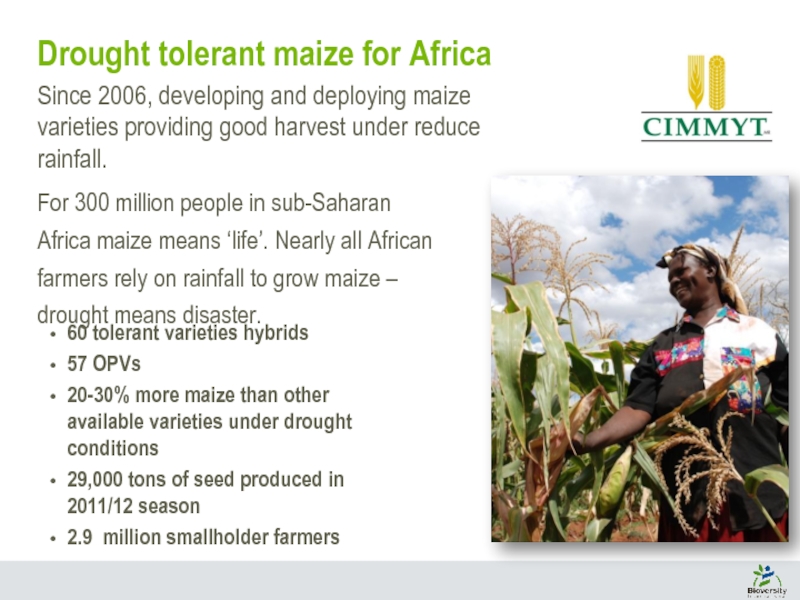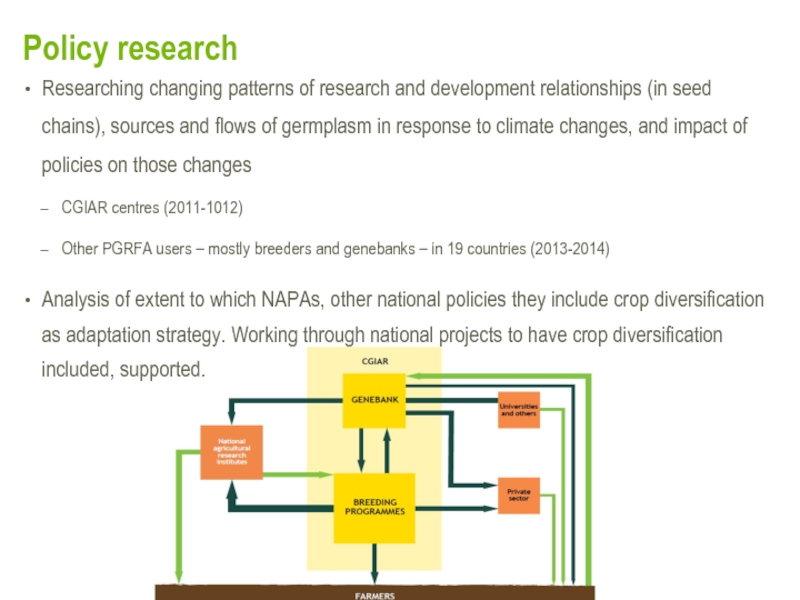- Главная
- Разное
- Дизайн
- Бизнес и предпринимательство
- Аналитика
- Образование
- Развлечения
- Красота и здоровье
- Финансы
- Государство
- Путешествия
- Спорт
- Недвижимость
- Армия
- Графика
- Культурология
- Еда и кулинария
- Лингвистика
- Английский язык
- Астрономия
- Алгебра
- Биология
- География
- Детские презентации
- Информатика
- История
- Литература
- Маркетинг
- Математика
- Медицина
- Менеджмент
- Музыка
- МХК
- Немецкий язык
- ОБЖ
- Обществознание
- Окружающий мир
- Педагогика
- Русский язык
- Технология
- Физика
- Философия
- Химия
- Шаблоны, картинки для презентаций
- Экология
- Экономика
- Юриспруденция
Crop diversity for climate change adaptation Michael Halewood, Bioversity International 8 April 2014 презентация
Содержание
- 1. Crop diversity for climate change adaptation Michael Halewood, Bioversity International 8 April 2014
- 2. Led by the International Center
- 3. Research themes Geographical engagement
- 4. http://ccafs.cgiar.org/
- 5. Table of contents What do
- 6. What we know
- 7. Estimated impact of +3°C change on crop
- 8. What we know about the role of
- 9. A static, one-time adaptation
- 10. What we know about policy
- 11. What we need to investigate
- 12. How to identify highest potential (in terms
- 13. Addressing knowledge gaps
- 14. The ‘Seeds for Needs’ approach
- 15. The Seeds for Needs approach Combining climate
- 16. Participatory evaluation
- 17. Engaging farmers
- 18. Drought tolerant maize for Africa 60 tolerant
- 19. An agricultural technology evaluation database for climate
- 20. CIAT is supporting participatory variety selection of
- 21. Researching changing patterns of research and
- 22. Research and capacity building for implementation/participation in
- 23. Translating research into practice
- 24. Translating research into practice Policies Participatory approaches Capacity building
- 25. 1. Farmers’ needs analysis, and 2. Selection
- 26. Thank you
Слайд 1
Crop diversity for climate change adaptation
Michael Halewood, Bioversity International
8 April
Слайд 2
Led by the International Center for Tropical Agriculture (CIAT), Program manager from
The program is carried out with funding support from governments and aid agencies, both through the CGIAR Fund and bilaterally: 57 million in 2013
The CGIAR Research Program on Climate Change, Agriculture and Food Security (CCAFS)
Слайд 5
Table of contents
What do we know about use of crop diversity
What are there knowledge gaps that need to be addressed?
How is CCAFS addressing them?
How will research results be translated into practice?
The CGIAR Research Program on Climate Change, Agriculture and Food Security (CCAFS)
Слайд 7Estimated impact of +3°C change on crop yields by 2050
Changes in
Changes in groundwater and river flows
Source: CCAFS
Слайд 8What we know about the role of crop diversity
We know the
Can increase the resilience of agricultural production systems
Is a source of useful traits to adapt to changing climatic conditions
Слайд 9
A static, one-time adaptation response is not enough: capacity to continuously
Adaptive capacity must be continuous, rolling
Слайд 10
What we know about policy challenges
Policies and public interventions oriented towards
Public investments on seed often focus on few crops and few varieties
Policies designed with other objectives in mind can have negative effect on availability and use crop diversity
Countries increasing interdependence on plant genetic resources often overlooked. Availability is limited
Rarely integrated into national climate change adaptation strategies
Слайд 12How to identify highest potential (in terms of adaptation) materials in
In what situations does crop diversity have high/low potential to contribute to adaptation and farmers’ livelihoods?
What diversity-based adaptation interventions have the most potential to promote gender equity?
What is the value of the gains that can be made through crop diversification? How can such information be used for trade-off decisions?
How can we scale up projects so that large numbers of farmers can deploy crop diversity to adapt to climate-related stresses?
Слайд 15The Seeds for Needs approach
Combining climate change data with data on
Слайд 18Drought tolerant maize for Africa
60 tolerant varieties hybrids
57 OPVs
20-30% more maize
29,000 tons of seed produced in 2011/12 season
2.9 million smallholder farmers
Since 2006, developing and deploying maize varieties providing good harvest under reduce rainfall.
For 300 million people in sub-Saharan Africa maize means ‘life’. Nearly all African farmers rely on rainfall to grow maize – drought means disaster.
Слайд 19An agricultural technology evaluation database for climate change analysis to:
facilitate the
form the basis for improving models of agricultural production under current and future conditions and for evaluating the efficacy of trialed materials for adaptation.
AgTrials
Слайд 20CIAT is supporting participatory variety selection of beans suited to local
With IRRI and IFPRI, improving modelling framework for cassava, beans, rice and tropical forages to prioritize technology development in the face of climate change
ICARDA is using some of the similar suit of tools to identify and characterize analogue sites in WA, EA and SAsia suitable for testing breeding lines and as potential sources of climate change adapted germplasm
IRRI has developed a model to simulate of rice yield losses/gains under different production situations, injury profiles and improved crop management and protection technologies.
ICRISAT has supported farmer knowledge exchanges regarding adaptation strategies and technologies in Tanzania and Kenya
Other centres are breeding for traits adapted to climate change, usually in CGIAR Research Programmes on commodities
Bioversity International: researching use of traditional crop varietal diversity to reduce crop loss to pest and disease attacks (under CRP WLE).
Additional initiatives
Слайд 21
Researching changing patterns of research and development relationships (in seed chains),
CGIAR centres (2011-1012)
Other PGRFA users – mostly breeders and genebanks – in 19 countries (2013-2014)
Analysis of extent to which NAPAs, other national policies they include crop diversification as adaptation strategy. Working through national projects to have crop diversification included, supported.
Policy research
Source: CCAFS
Слайд 22Research and capacity building for implementation/participation in the Multilateral System of
Research on influence of subsidies in varietal seed multiplication/availability in developing countries
Network analyses of factors affecting diffusion and uptake of climate smart practices, including crop diversification
Policy research
Countries classified based on the number of transfers of
material from CGIAR breeding programs in 2009. Source: CGIAR database
Слайд 251. Farmers’ needs analysis, and
2. Selection
of tools and software,
and
germplasm
identification
4. Germplasm acquisition
5. Field testing of germplasm
Documentation
Documentation
Documentation
Documentation
3. Climate
change analysis and
6. Germplasm conservation
8. Communication
formulation of objectives, and
7. Evaluation of the research process
Documentation
Resilient Seed Systems and Adaptation to Climate Change R&D Process
Identification of documentation options
Documentation
agreeing on forms of participation
Documentation































